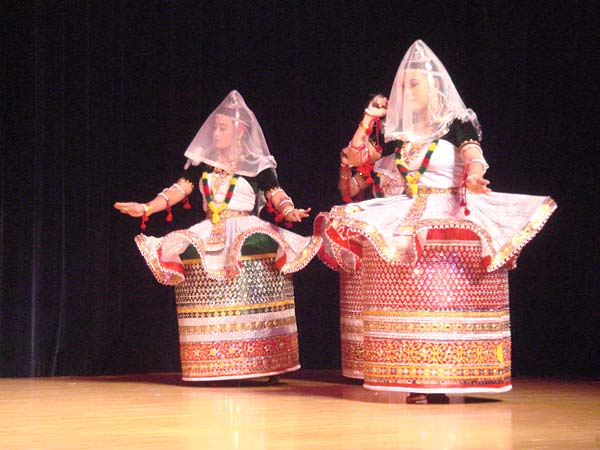Originated in Manipur, Manipuri is an Indian classical dance form. Read further to know about Manipuri classical dance of India.
Manipuri Dance Form

Manipuri is the classical dance from the Manipur
region in the North East. Very much religious and associated to Vaishnav
cult of Hinduism, the art form primarily depicts episodes from the life
of Lord Vishnu. Manipuri dance style is multifaceted and ranges from the
softest feminine to the vigorous masculine. Dignified grace is found in
every aspect and the range it offers in technique, rhythmic and tempo,
which makes a Manipuri recital an absorbing and exhilarating experience.
Originating from a north-eastern state of India, Manipur, the movements
of the body, feet and facial expressions in the dance are delicate and
aspire to exhibit complete devotion and gracefulness.
History
The past and origin of Manipuri dance is not clear, as there are many
myths and legends that have been associated with it. The Manipuris
consider themselves the descendants of the Gandharvas, who were the
legendary musicians, and dancers in the celestial courts of Indira. The
earliest records of this dance form date back to about 100 AD. It was
King Bhagyachandra of 17th century, who established Manipuri dance on a
systematic basis. He gave the Rasleelas (dance dramas) and Sankirtan
(form of invocation) a new outlook and composed three of the five types
of Ras Lilas - the Maha Ras, the Basanta Ras and the Kunja Ras.
Apart from codifying the style of Ras Leela, King Bhagyachandra also
designed the beautiful Manipuri dance costume. In the 19th century,
Maharaja Gambhir Singh composed the two parengs of the tandava type -
the Goshtha Bhangi Pareng and the Goshtha Vrindaban Pareng. During this
time, Maharaja Chandra Kirti Singh shaped the 64 Pung choloms or drum
dances and two parengs of the Lasya type - the Vrindaban Bhangi Pareng
and Khrumba Bhangi Pareng. Nitya Ras have also been accredited to him.
However, it was the continuous efforts of Rabindranath Tagore and other
Gurus that the dance became popular even outside the region.
The dance form took a step ahead in 1954 when the Manipur Dance College
of Imphal was formed. Today named as, Jawaharlal Nehru Manipur Dance
Academy, the institution had started with three great exponents of the
genre as its faculty member - Guru Amubi Singh, Guru Amudon Sharma and
Guru Atomba Singh. With time, Manipuri dance gained much appreciation
and admiration. Later in 1972, Manipuri Nartanalaya was founded in
Mumbai, Kolkata and Imphal, while in New Delhi, Manipuri Nrityashram was
established
Dance Form
The Vaishnava faith brought along with it the origin of the Manipuri
dance. The repertoire is dominated by the themes from the Vishnu
Puranas, Bhagvata Puranas, and Geeta Govinda. Slow and gracious
movements differentiate Manipuri from other dance styles. The delicate
arm movements and gentle foot work characterizes this dance form. Any
form of jerks, sharp edges or straight lines in the dance is not seen,
which is the only reason as to why Manipuri dance is known for its
undulating and soft appearance. While the female 'Rasa' dances is based
on the Radha-Krishna theme feature group ballets and solos, the male
'Sankirtana' dances are performed to the pulsating rhythm of the
Manipuri Dholak and are full of vitality and energy.

